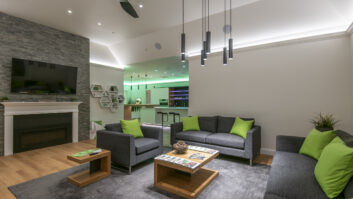Factory-level sales of networked home-control products will hit $890 million in 2008, up from last year’s approximate $385 million, for a five-year compound annual growth rate averaging 18 percent per year, according to ABI, the technology market research company.
The statistics include networked-system sales by homebuilders and custom installers as well as over-the-counter sales to do-it-yourselfers, he said. The do-it-yourself market will expand from about $70 million in 2003 to $100 million in 2008, ABI said.
Networked products will account for almost a quarter of the home-control industry’s $4 billion in revenue in 2008, according to a forecast by ABI senior analyst Erik Michielsen. In 2003, home-control revenues were $1.7 billion.
Home-control systems include lighting, HVAC, security systems and entertainment systems, ABI said. Network technologies can integrate the in-home monitoring control of these systems and other standalone products, including major appliances and consumer electronics. Via broadband residential gateways, monitoring and control can be extended offsite to homeowners using Internet-connected PCs at the office or wireless phones on the road.
ABI projects gateway sales of almost 20 million units in 2008, up from last year’s sales in the low 200,000s.
“One of the key inhibitors to home automation has been the lack of integration between multiple systems,” ABI’s report said. “In recent months, however, digital media adapters have come to market, enabling IP-connectivity for a number of components in the home.” Zensys, for example, is working with Intel to embed low-cost low-power wireless Z-Wave connectivity into once-separate home-automation systems.
The Zigbee Alliance “continues to demonstrate large-company commitment to low-power, low-datarate home automation wireless networking across lighting, security, consumer electronics, computing and appliances,” ABI said.
Although the PC will play a “substantial role” as an Internet gateway, it might cede most of its gateway potential to dedicated home-control gateways that create “a more seamless system,” ABI said. “The computer will maintain an advantage with its computing power and set of traditionally accepted and demanded applications,” Michielsen explained. “However, it remains to be seen if service providers [including utilities] will push their own gateways at lower [subsidized] prices in efforts to provide complementary services to the PC at a much lower cost.”
Gateways will be used not only to connect HVAC, security and lighting systems but also to connect consumer electronics, PCs and network-capable appliances, ABI said. An example of a CE gateway application would be Sony’s planned Internet-connected Location-Free TV system, which lets users view all of the content stored on a DVD megachanger or PVR from anywhere in the home through a portable, Wi-Fi-equipped 12-inch LCD monitor with integrated speakers. Consumers could also view the content from remote sites through a handheld personal viewer when it’s connected to the Internet via an Ethernet or Wi-Fi network or Wi-Fi hot spot.
Information on ABI is available at www.abiresearch.com.













